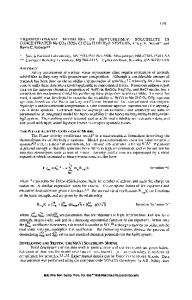The Solubility of Th(IV) and U(IV) Hydrous Oxides in Concentrated Nahco 3 and Na 2 Co 3 Solutions
- PDF / 476,595 Bytes
- 8 Pages / 414.72 x 648 pts Page_size
- 73 Downloads / 340 Views
THE SOLUBILITY OF Th(IV) AND U(IV) HYDROUS OXIDES IN CONCENTRATED NaHCO 3 AND Na 2CO 3 SOLUTIONS Dhanpat Rai, Andrew R. Felmy, Dean A. Moore, and Marvin J. Mason Pacific Northwest Laboratory, Richland, Washington 99352
ABSTRACT 2 The solubility of Th(IV) and U(IV) hydrous oxide was studied in the aqueous HC0 3--CO3 --OH--H 20 system extending to high concentration. The solubility of the Th(IV) and U(IV) hydrous oxides increases dramatically in both high bicarbonate and carbonate solutions and decreases with the increase in hydroxide at a fixed carbonate concentration. In general, the observed solubility of Th(IV) hydrous oxide at a given total carbonate concentration was three to four orders of magnitude higher than the solubility of U(IV) hydrous oxide. In the studies of the U(IV) system, extreme caution was used to ensure that the dissolved U was present as U(IV). Oxidation state analyses and systematic trends in the U(IV) solubility data similar to those for Th(IV), which is not redox sensitive, indicated that the dissolved U was present
as U(IV).
INTRODUCTION Carbonate, either as carbonic acid, bicarbonate ion, or carbonate ion, is a ubiquitous component of groundwater systems. Various carbonate species form aqueous complexes with several aqueous actinide species including Am3+, UO 2 2 +, NpO 2+, Th4 +, and U4 '. The complexes with the tetravalent actinides (i.e., Th[IV], U[IV], Np[IV], and Pu[IV]) can be strong. Such strong complexes may increase the 1 51 which could be present in nuclear solubility of oxides and hydrous oxides of tetravalent actinides, waste repositories. Unfortunately, only limited experimental data are available for the solubility of Th(IV) and U(IV) compounds in carbonate solutions. Osthols et al. (1994)[61 have reviewed the past research on Th-carbonate systems and to date have reported the best data on the solubility of ThO 2(act) in 0.5 M NaCIO4 as a function of pH and C0 2(g), although these studies extended to only 0.1 M in total carbonate. To the best of our knowledge, there are no reliable solubility data for U(IV) hydrous oxide in carbonate solutions.
In this study the solubility of Th0 2 (am) and U0 2(am) was examined in HCO3, C0 3, and mixed OHCO3 solutions extending to high dissolved carbonate (as high as 6m). The emphasis of this work was on determining the effect of carbonate on the solubilities of ThO 2(am) and U0 2(am), and comparing and contrasting the solubility of these two actinides. Thorough thermodynamic interpretations of these data and reliable literature data using the models (Pitzer and coworkers) most appropriate for concentrated salt solutions will be discussed elsewhere.
METHODS AND MATERIALS Special Precautions for U(aV) Because U(IV) is readily oxidized to U(VI) in the presence of 02, several precautions as recommended by Rai et al. (1990)131 were taken to minimize oxidation during preparation of the stock solution and during the equilibration. These precautions included 1) preparing the concentrated U(IV) stock solution (-666 g U/L) in -0.46 M HCI (where
Data Loading...











